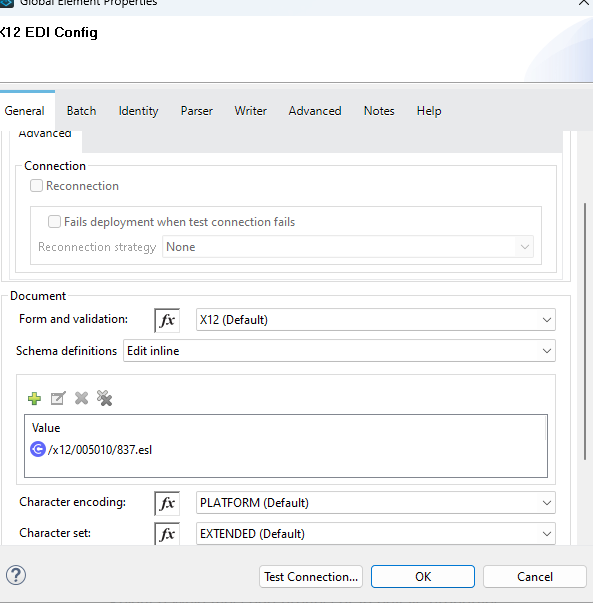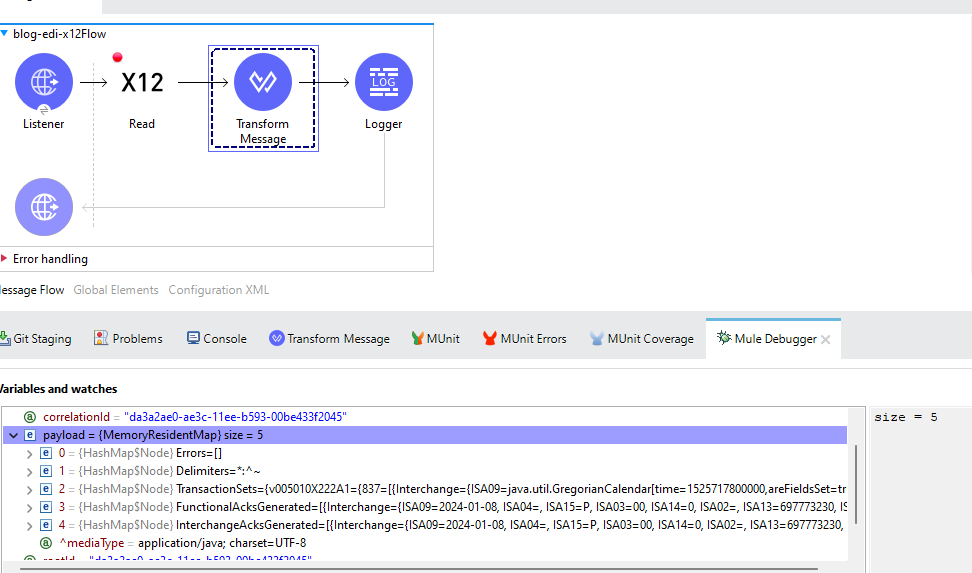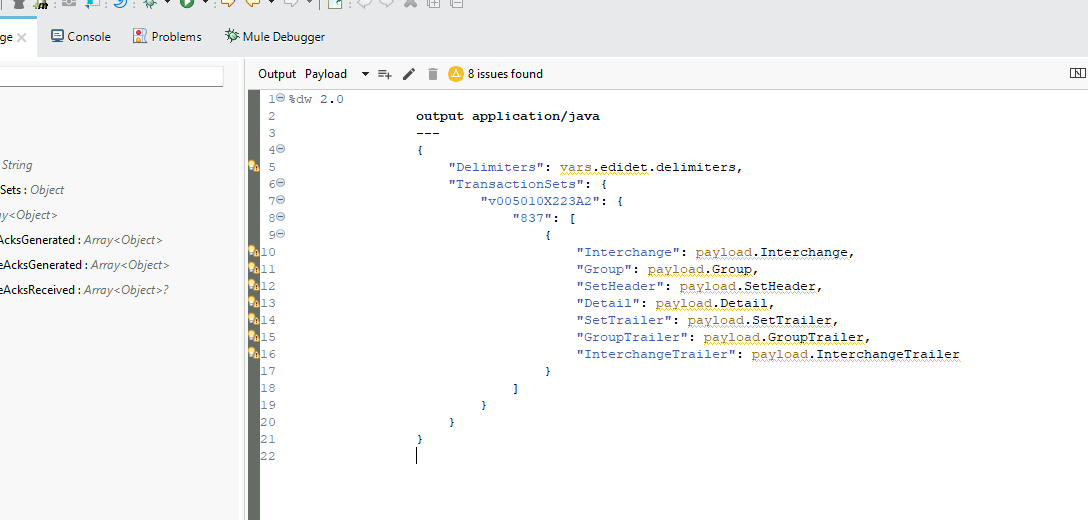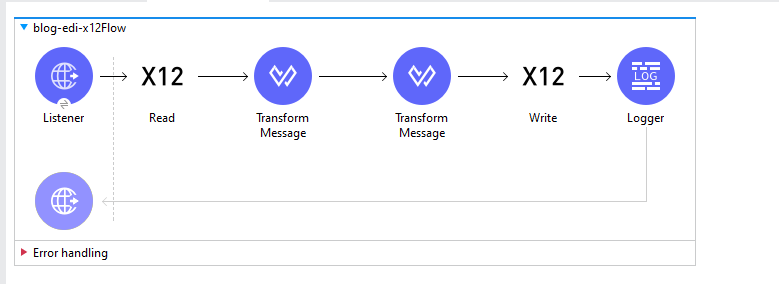X12 Write Operation – Generating EDI Files in MuleSoft

Introduction
In Part 1 of this blog series, we discussed what an EDI X12 file is and how to read it using the X12 Read Connector. Now, let us move to the next step—writing an X12 EDI file using MuleSoft.
Part 1 Blog link: https://blogs.mulecraft.in/how-to-seamlessly-integrate-and-handle-edi-files-with-mules-x12-connector-a-comprehensive-guide/
The X12 Write Connector allows us to generate EDI files from structured data formats like JSON or XML. In this blog, we’ll cover:
- How to configure the X12 Write Connector
- Mapping source data to X12 format using Data Weave (output application/java)
- Writing and validating an X12 file
1. Understanding the X12 Write Connector
The X12 Write Connector converts input data into an X12-compliant format while ensuring:
✔ Proper segment delimiters
✔ Correct segment order
✔ Compliance with X12 schema
Key configurations:
- EDI Standard Version (e.g., 5010)
- Schema Validation
- Custom Delimiters (if needed)
Sample EDI file
You can download sample EDI file for testing purposes, here we have used sample 837 claim EDI file. https://www.betterhealthtogether.org/s/CHPW_Claimdata.txt
To download different samples use the below link https://www.betterhealthtogether.org/bold-solutions-content/companion-guides-xsd87
2. Configuring the X12 Write Connector in MuleSoft
Let’s configure the X12 Write Connector to generate an 837 (Healthcare Claim) transaction file.

After x12 Read
We assume that the after x12 read we are getting a payload sizeOf = 5, in that we will have Errors, Delimiters, TransactionSets, FunctionalAcksGenerated and InterchangeAcksGenerated.

Summary of the X12 Read Payload Structure
| Key | Purpose |
|---|---|
| Errors | Captures any parsing errors found in the X12 file. |
| Delimiters | Stores element, component, segment, and repetition separators. |
| TransactionSets | Contains the actual EDI business transactions (e.g., 837, 835, 277). |
| FunctionalAcksGenerated | Stores the 997 Functional Acknowledgment response (Accepted/Rejected). |
| InterchangeAcksGenerated | Stores the TA1 Interchange Acknowledgment response (Accepted/Rejected). |
3. Implementing the X12 Write Flow
Below is a MuleSoft flow that converts JSON into an X12 file:

Mule Flow
The above payload we used in the transform message before x12 write connector for write the edi file

4. Validating the Generated X12 File
Once the Mule flow runs successfully, a sample output file may look like this:
ISA*00* *00* *ZZ*123456789 *ZZ*987654321 *240129*1200*U*00501*000000123*0*P*:~
GS*HC*123456*987654*20240129*1200*1*X*005010X223A2~
ST*837*1001~
CLM*1234567890*1000.00***11*1*Y*A*1*Y~
SE*10*1001~
GE*1*1~
IEA*1*000000123~
How to Validate the X12 File?
- Use EDI Notepad or an online EDI validator to check compliance.
- Ensure that segment order and required fields are correct.
- If there are no significant errors, it means the flow successfully passed through the X12 Write connector; otherwise, an error has occurred.
5. Handling Errors in X12 Write Connector
When passing an incorrect payload, the X12 Write Connector validates the structure and throws an error indicating which segment is incorrect.
Scenario: Passing an Incorrect Payload
Let’s say we mistakenly pass an input payload where the ST segment is missing.
Incorrect Payload (Missing ST Segment - commented)

Expected Error Message
"Error writing X12: Missing required ST segment in transaction set...."
This indicates that the ST segment is missing, causing the X12 Write Connector to fail.
To Avoid Those Errors:
- Use Schema Validation: Ensure your input data conforms to X12 schema before passing it to the X12 Write Connector.
- Enable Detailed Logging: Capture detailed logs for troubleshooting.
- Validate Segments in Data Weave: Pre-check required segments before writing the X12 file.
- Implement Error Handling: Use Mule error handling strategies like Try Scope, On-Error Propagate, or On-Error Continue.
6. Common Issues and Troubleshooting
- Segment Missing – Ensure all required segments are mapped properly.
- Invalid Delimiters – Set the correct delimiters (: or *).
- Schema Validation Errors – Make sure the correct X12 version is used in Transaction Sets.
Conclusion
In this blog, we covered how to generate an X12 EDI file using the X12 Write Connector in MuleSoft, from mapping structured data to writing a compliant 837 transaction file. We also explored the key components of the X12 Read payload, ensuring that delimiters, transaction sets, and acknowledgments are correctly processed before writing the output. Validating the generated EDI file is crucial to maintaining compliance and preventing errors, and we discussed tools and techniques to achieve this. By leveraging MuleSoft’s X12 Connector, businesses can automate EDI processing efficiently, ensuring seamless data exchange between systems. Stay tuned!
